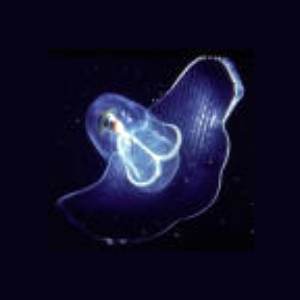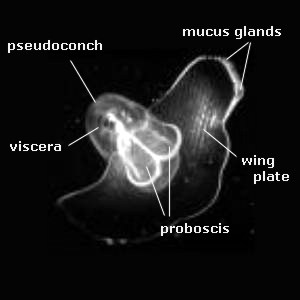

Corolla spectabilis
Dall, 1871
Order: THECOSOMATA
Suborder: PSEUDOTHECOSOMATA
Family: Cymbulidae
DISTRIBUTION
Worldwide
PHOTO
Muckleteo, north of Seattle, Puget Sound, Washington, USA. Depth approx 15ft. Photo: Bryan Dieter
There are two orders of planktonic sea slugs which are collectively called pteropods - Thecosomata & Gymnosomata. They are not closely related, and as their names suggest, the gymnosomes lack a shell, and the thecosomes possess one. However, as we often find in opisthobranch taxonomy, nothing is quite that simple, and in some of the more advanced thecosomes, such as Corolla, the external shell is replaced by an internal pseudoconch.
Corolla, like all pseudothecosomes, is characterised by the fusion of the thecosome wings into a single wing plate and the presence of a proboscis formed from the fusion of the lobes of the foot. In Corolla the external calcareous shell has been replaced by a gelatinous internal pseudoconch, which contains the visceral mass. The pseudoconch can grow to about 8cm in length in large animals, with a wingplate span of 16cm. As species of Corolla have mainly been defined on size, it is uncertain just how many species exist.
Corolla swims by flapping the wing plate. Like all pseudothecosomes, they normally swim by pushing their shell or pseudoconch through the water, quite the opposite of euthecosomes, which pull the shell along. Corolla has been reported at speeds of 45cm/sec when swimming rapidly.
One of the most interesting features of thecosomes is their method of feeding, discovered by Gilmer in the 1970s by SCUBA observations. Thecosomes produce a mucous web, many times the size of the animal, to entangle and trap planktonic food. While in euthecosomes the web is usually spherical, in pseudothecosomes it is usually a funnel-shaped or flattened sheet. In Corolla the feeding web, produced by the mucus glands along the edge of the wing plate, can have a diameter of about 2m. When feeding, the animal slowly sinks in the water entangling plankton and organic particles in the web. Parts of the mucous web and its entangled food are ingested by the proboscis. In Corolla, the radula, jaws and salivary glands have all been lost.
For comparison see shelled euthecosome Creseis acicula and gymnosome Clione limacina.
Reference:
• Lalli, C.M. & Gilmer, R.W. (1989) Pelagic Snails. The biology of holoplanktonic gastropod molluscs. Stanford University Press: Stanford, California.
Rudman, W.B., 2002 (December 12) Corolla spectabilis Dall, 1871. [In] Sea Slug Forum. Australian Museum, Sydney. Available from http://www.seaslugforum.net/factsheet/corospec
